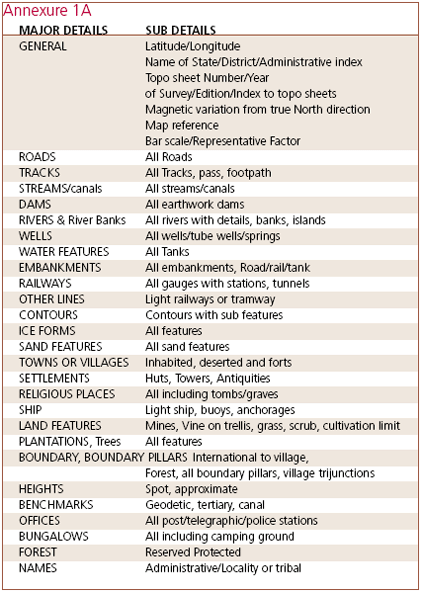| Policy | |
India’s National Map Policy: HOPE vs HYPE
|
||||
National Map Policy1 PreambleAll socio-economic developmental activities, conservation of natural resources, planning for disaster mitigation and infrastructure development require high quality spatial data. The advancements in digital technologies have now made it possible to use diverse spatial databases in an integrated manner. The responsibility for producing, maintaining and disseminating the topographic map database of the whole country, which is the foundation of all spatial data vests with the Survey of India (SOI). Recently, SOI has been mandated to take a leadership role in liberalizing access of spatial data to user groups without jeopardizing national security. To perform this role, the policy on dissemination of maps and spatial data needs to be clearly stated. 2 Objectives• To provide, maintain and allow access and make available the National Topographic Database (NTDB) of the SOI conforming to national standards. • To promote the use of geospatial knowledge and intelligence through partnerships and other mechanisms by all sections of the society and work towards a knowledge-based society. 3 Two series of mapsTo ensure that in the furtherance of this policy, national security objectives are fully safeguarded, it has been decided that there will be two series of maps namely a. Defence Series Maps (DSMs)- These will be the topographical maps (on Everest/WGS-84 Datum and Polyconic/UTM Projection) on various scales (with heights, contours and full content without dilution of accuracy). These will mainly cater for defence and national security requirements. This series of maps (in analogue or digital forms) for the entire country will be classified, as appropriate, and the guidelines regarding their use will be formulated by the Ministry of Defence. b. Open Series Maps (OSMs) – OSMs will be brought out exclusively by SOI, primarily for supporting development activities in the country. OSMs shall bear different map sheet numbers and will be in UTM Projection on WGS-84 datum. Each of these OSMs (in both hard copy and digital form) will become “Unrestricted” after obtaining a one-time clearance of the Ministry of Defence. The content of the OSMs will be as given in Annexure ‘iA’. SOI will ensure that no civil HOPE vs HYPE and military Vulnerable Areas and Vulnerable Points (VA’s/ VP’s) are shown on OSMs. The SOI will issue from time to time detailed guidelines regarding all aspects of the OSMs like procedure for access by user agencies, further dissemination/sharing of OSMs amongst user agencies with or without value additions, ways and means of protecting business and commercial interests of SOI in the data and other incidental matters. Users will be allowed to publish maps on hard copy and web with or without GIS database. However, if the international boundary is depicted on the map, certification by SOI will be necessary. In addition, the SOI is currently preparing City Maps. These City Maps will be on large scales in WGS-84 datum and in public domain. The contents of such maps will be decided by the SOI in consultation with Ministry of Defence. 4 National Topographical DatabaseSOI will continue to create, develop and maintain the National Topographical Data Base (NTDB) in analogue and digital forms consisting of following data sets: Both the DSMs and OSMs will be derived from the NTDB. 5 Map dissemination and usage• Open Series Maps of scales larger than 1:1 million either in analogue or digital formats can be disseminated by SOI by sale or through an agreement to any agency for specific end use. This transaction will be registered in the Registration database with details of the receiving agency, end use etc. 6 Applicability of previous instructionsThe Ministry of Defence has from time to time issued detailed guidelines on various aspects of map access and use. These instructions shall continue to hold good but for the modifications cited herein. |
||||













 (No Ratings Yet)
(No Ratings Yet)




